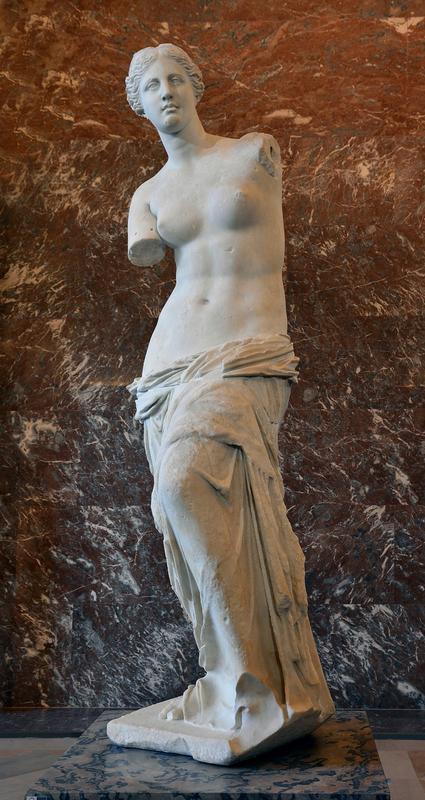More about Venus de Milo
- All
- Info
- Shop

Contributor
Despite her name, nobody actually knows who the Venus de Milo is.
Viewers like to think she’s the ever-so-popular goddess of love and romance, but she really doesn’t sport any kind of iconography that would point to the definitive answer of her identity. Artsy-fartsy experts are pretty sure that something to indicate who this femme fatale really is conveniently located on or in one of her missing arms.
Some sources say that when she was found, a hand with an apple in it was found nearby, which would mean that this is indeed Aphrodite or Venus, the goddess of love, who won the apple in a fair fight between Athena, goddess of wisdom and war, and Hera, goddess of the home and wifely duties. Like her arms, though, the hand is conveniently missing. Since we really don’t know, she could also be Amphitrite, a sea goddess who was worshipped in Milo; Artemis, the goddess of the hunt and a general badass; or some random nymph.
Even without an identity, this mystery woman is one heck of a drama queen. After being discovered by a farmer in 1820 on the island of Milo while he was digging for a well (he “accidentally” tossed her back into the hole that he found her in, then had to dig her back out to give her to the authorities), Venus was bounced around from admirer to admirer, starting with a French naval man named Oliver Vouter. He declared her a masterpiece convinced several other Frenchmen, including the Marquis de Rivière, that she was every bit as beautiful as he thought and she should be taken to France.
The Marquis de Rivière agreed that Venus shouldn’t go to the Turks, who technically owned the island of Milo and the statue, so he bought the statue and gifted her to King Louis the XVIII in 1821. Needless to say, the Turks weren’t thrilled that their love goddess was stolen out from under their noses, so they heavily fined the local authorities on Milo. Recognizing that it was really his fault that the government on Milo was fined, the Marquis de Rivière covered the Turkish fines.
Despite all the trouble that everyone went to in order to get the statue, Louis wasn’t overly fond of her and donated her to the Louvre only a year after he got it.
Sources
- Astier, Marie-Bénédicte. “Work Aphrodite, Known as the ‘Venus de Milo.’” 2005. Accessed December 18, 2016. http://www.louvre.fr/en/oeuvre-notices/aphrodite-known-venus-de-milo.
- LearnMediaOfAmerica. “The Venus de Milo.” YouTube. February 17, 2008. Posted December 18, 2016. https://www.youtube.com/watch?v=08--tsUCzWg.
- “Venus de Milo.” Accessed December 18, 2016. http://penelope.uchicago.edu/~grout/encyclopaedia_romana/miscellanea/ve….
Featured Content
Here is what Wikipedia says about Venus de Milo
The Venus de Milo or Aphrodite of Melos is an ancient Greek marble sculpture that was created during the Hellenistic period. Its exact dating is uncertain, but the modern consensus places it in the 2nd century BC, perhaps between 160 and 110 BC. It was rediscovered in 1820 on the island of Milos, Greece, and has been displayed at the Louvre Museum since 1821. Since the statue's discovery, it had become one of the most famous works of ancient Greek sculpture in the world.
The Venus de Milo is believed to depict Aphrodite, the Greek goddess of love, whose Roman counterpart was Venus. Made of Parian marble, the statue is larger than life size, standing over 2 metres (6 ft 7 in) high. The statue is missing both arms. The original position of these missing arms is unknown. The sculpture was originally identified as depicting Aphrodite holding the apple of discord as a marble hand holding an apple was found alongside it; recent scientific analysis supports the identification of this hand as part of the sculpture. On the basis of a now-lost inscription found near the sculpture, it has been attributed to Alexandros from Antioch on the Maeander, though the name on the inscription is uncertain and its connection to the Venus is disputed.
The Venus de Milo rapidly became a cornerstone of the Louvre's antiquities collection in the aftermath of the Napoleonic Wars, and its fame spread through distribution in photographs and three-dimensional copies. The statue inspired over 70 poems, influenced 19th-century art and the Surrealist movement in the early 20th century, and has been featured in various modern artistic projects, including film and advertising. In contrast to the popular appreciation of the sculpture, scholars have been more critical since it was dated to the Hellenistic rather than classical period, preferring to study classical sculptures mentioned in ancient written sources.
Check out the full Wikipedia article about Venus de Milo

















